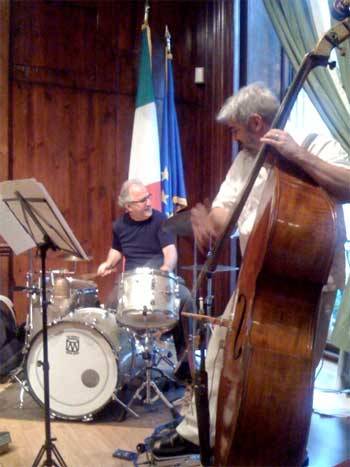Italian "Docs" on the Cutting Edge
New York City on any given night offers more live music choices than most other cities do in a month. Venues may come and go, victims of a merciless real estate market and/or changing tastes. But such vicissitudes don’t affect the unequalled abundance and diversity of this town’s musical offerings.
On the last Monday in June, a boxy, wood-paneled space in the Italian Cultural Institute became the hippest room in Manhattan as Italian Doc Remix (IDR) filled it with a sound that could only have been born in New York. The sextet, led by Italian-born guitarist Marco Cappelli and Italian American percussionist Jim Pugliese, plays music rooted in southern Italian tradition but that also has a global reach, taking in jazz, rock, and hip hop. IDR uses tarantella, pizzica, tammurriata and southern Italian banda music as launching pads for fruitful and often thrilling collective improvisation. But the Mezzogiorno roots are never just points of departure; they instead infuse the group’s sound as thoroughly as the blues permeates jazz.
The band played selections from their first CD, Italian DOC Remix, soon to be released on the Italian label Itinera. They opened with “Take the ‘G’ Train,” a tarantella with a melody line voiced by Doug Wieselman on clarinet and Jose Davila on trombone. After this auspicious but easy-going beginning, the set became more adventurous and exciting. “Model Barber” incorporated segments of a recorded interview with Lenny Ranaldo, a Brooklyn barber and second generation Italian American, as the band jammed with a supple flow reminiscent of the Grateful Dead.
For the rest of the nearly two-hour set IDR served up a half-dozen pieces based in southern Italian styles, not canzone napoletana (Neapolitan song), as Marco Cappelli noted, but in folk and ritual music associated with village life. He remarked that at first he had been reluctant to use folk materials, having played traditional music in the past. But he became intrigued by what he described as the Italian American relationship to cultural memory, and decided to re-cast Old World idioms in contemporary contexts. As he said, “I had no wish to make them sound like the originals.”
“Fronna e Lime” embodied Cappelli’s concept. The piece, which mixed three traditional forms, tammurriata, pizzica, and fronne e limone, opened with turntablist DJ Logic (Jason Kibler) scratching on an LP recording of a vocalist singing a fronne e limone while the horns played unison legato lines. The band slowly built momentum, driven by Pugliese’s powerful drumming, ending up in a place where tradition and modernity meet -- the global village of New York.
“Igino’s Lullaby,” a song from Salerno that Cappelli said his father used to sing, had Davila making voice-like sounds on muted trombone while the distinctive boing-boing-boing of a marranzano (jew’s harp) added rhythm and folk flavor. “Il Morte di Tony Soprano,” which Cappelli said he wrote when HBO series was new, was inspired by a funeral procession he’d witnessed on Procida. He was struck not only by the sound of the village marching band but by the black-shrouded professional mourners, local women who enacted an impressive public performance of grief. The piece evoked the somber stateliness of the funeral march and, in Wieselman’s clarinet and Davila’s tuba, the contained but powerful emotion of the wailing women. DJ Logic’s syncopated turntable solo fit better here than his somewhat distracting work on “Fronna e Lime.”
About midway through the concert IDR brought out one of New York’s most in-demand players, the guitarist Marc Ribot. (Much admired for his work with Tom Waits, Ribot also has recorded and performed with Italian singer-songwriter Vinicio Capossela. He’ll back Capossela at the latter’s July 2 show at the Highline Ballroom.) On “IDR,” he raised the room’s temperature with a scalding, blues-inflected solo.
On “Maria’s Anthem,” a piece Cappelli dedicated to his family’s ancestral village of Casalbuono, near the Campania-Basilicata border, Cappelli played a melodic solo that contrasted nicely with Ribot’s red-hot turn.
“Williamsburg Variations,” the closer, opened with Wieselman essaying a sprightly melody on clarinet. Even with its marked New Orleans influence, the number’s rambunctious energy felt totally New York. Like the set as a whole, it was smartly conceived, surprising, and constantly kinetic.
For me, Italian Doc Remix answers a question I’ve been asking myself for some years now: where is the Italian American musical avant-garde? Jewish American musicians, from klezmer revivalists like The Klezmatics to such exploratory players as saxophonist John Zorn, clarinetist David Krakauer, and Marc Ribot, blend Eastern European and Sephardic music with jazz, rock, and Afro-Cuban. The great jazz saxophonist Joe Lovano is the rare Italian American player who deliberately draws inspiration from his ethnic roots, on albums like “Viva Caruso” and Sicilian-themed compositions like “Miss Etna” and “Bread and Wine.” But such projects are not central to Lovano’s work, which mainly hews to an African American aesthetic.
Now, with IDR, New York has an Italian-led (though not exclusively Italian) band that marries tradition and innovation, respecting and honoring the roots even as the musicians venture beyond them. It’s about time.




































i-Italy
Facebook
Google+
This work may not be reproduced, in whole or in part, without prior written permission.
Questo lavoro non può essere riprodotto, in tutto o in parte, senza permesso scritto.